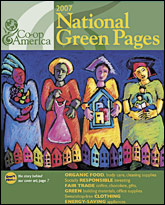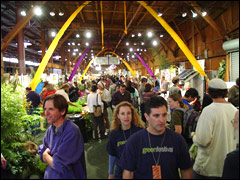
Alisa Gravitz.
What work do you do?
I have the great pleasure of serving as Co-op America’s executive director.
What does your organization do?
Co-op America uses the power of the marketplace to solve social and environmental problems. Our name itself stands for the idea of people in their economic roles (as consumers, workers, investors, and business leaders) cooperating to create a better world.
Co-op America focuses on economic and business strategies because, in this industrial age, the economic sector dominates public and private life. Too often, business as usual harms people, communities, and the environment. But it doesn’t have to be that way — business is an enormous engine that can be harnessed for shifting society to sustainability.

Our economic action program work includes corporate accountability, green business development, building sustainable communities, and mobilizing people to take action on these issues. Our campaigns focus on corporate accountability, from sweatshops to the climate crisis. Our websites and publications — National Green Pages, Real Money, the Co-op America Quarterly, and our Green Business Network — help people and businesses get the information they need to go green.
What are you working on at the moment? Any major projects?
We’ve got a big campaign underway to get major corporate climate polluters — auto, coal, utility companies — to clean up their act.
We’re working to expand the market for Fair Trade, one of the great ways to help producers around the world provide for their families and stay out of sweatshops. And we’re working with major magazines to help them switch to recycled paper.

A Green Festival throng.
Our Green Festivals — big celebrations of the green economy, our joint program with Global Exchange — feature inspiring speakers, green exhibitors, green careers, green home resources, music, art, dance, green films, and organic food, beer, and wine. Over the coming year, we’ll put on Green Festivals in Washington, D.C. (Oct. 14-15), San Francisco (Nov. 10-12), and Chicago (April 21-22, 2007). (Take our Green Living Survey for a chance to win a free trip to the San Francisco Green Festival.)
How do you get to work?
A wonderful two-mile walk through beautiful Washington, D.C., neighborhoods.
What long and winding road led you to your current position?
Growing up in a family steeped in community service, our lively dinner-table conversations were often about imagining a society that would be fair for all. In early 1970, I picked up the Earth Day reading list, and as I worked my way through it, my head began to swim with facts and figures about the demise of our environment. I was particularly struck by Rachel Carson’s Silent Spring.
Soon thereafter I started an environmental group at my school for the first Earth Day. I then chose economics and environmental sciences as my college majors, worked at a consulting firm on renewable energy, returned to school for an MBA, and moved to Washington to work for President Carter on energy efficiency and renewables.
When Carter lost the election, some colleagues and I began a consulting company to help nonprofits scale up. Co-op America was just starting up then and became one of my pro bono clients. Soon they convinced me to join them full time. Nearly 25 years later, the work continues to get more interesting — and more fun — every day.
Where were you born? Where do you live now?
Born in Virginia, my family eventually settled in Minnesota, where I spent most of those formative K-12 years. After another move that brought us east, I went to undergraduate and business school in Boston, and have now lived in Washington, D.C., for over 25 years.
What has been the worst moment in your professional life to date?
That would be the evening when my first Earth Day group was giving a presentation to the PTA. While cutting the lights for a slideshow, we managed to pull the circuit breaker for the entire building. There we were — a bunch of kids — trying to convince the PTA we had what it takes to create an ecology program for the whole district, and we plunged them into total darkness. And did I mention I was the one on stage when the lights went out, having just announced the slide show?
After my heart stopped pounding, I managed to conduct a conversation with the parents (in the dark) about this being what it would be like if we ran out of energy (while one of my co-conspirators found the custodian and the breaker switch). We found out later that the parents were impressed and thought the whole thing was planned, and the PTA gave us the go-ahead on the ecology program. It taught me to be fast on my feet in front of crowds, and to keep a flashlight in my backpack when running events!
Who is your environmental hero?
A generation of giants gave me a hand up to the work I’m doing — Rachel Carson, Donella Meadows, Barry Commoner, Paul Ehrlich, David Brower, Denis Hayes, Dr. Martin Luther King Jr., Gloria Steinem — many of whom I had the great blessing to learn from not only through their books and works, but in person.
What’s your environmental vice?
All those planes I take to do my environmental and social change work, even though we purchase carbon offsets for all of our miles traveled.
How do you spend your free time?
My husband and I are folk dancers and just came back from a week of dance camp. It was heaven — waltz in the morning, tango in the afternoon, contra dance in the evenings, and swing dance at night — all to live music.
Read any good books lately?
I just finished Luis Alberto Urrea’s The Hummingbird’s Daughter, a wonderful piece of magical, mesmerizing historical fiction about Mexico in the 1880s.
What’s your favorite place or ecosystem?
My Adams-Morgan neighborhood in Washington, D.C. It’s a quiet, dense, urban habitat where neighbors know each other — where two blocks in one direction you can find all the cuisines of the world and a half block the other way is a back entrance to Rock Creek Park, with over a hundred miles of hiking trails.
Who was your favorite musical artist when you were 18? How about now?
At 18, it was Harry Chapin; I wish he would have lived to keep writing those ballads about life and changing the world for another generation. Now, my husband and I collect instrumental folk music from all over the world.
What’s your favorite movie?
My favorites are the love stories like Outrageous, Clair de Femme, and Burnt by the Sun.
Which actor would play you in the story of your life?
I threw this one out to some friends at a dinner party, and we had fun picking someone for each of us. They went with Sissy Spacek for me, since more than one person accused us of looking like we’re sisters, with that red-headed spunk.
If you could have every InterActivist reader do one thing, what would it be?
Join us at Co-op America in using your economic power for good! We’d love it if you’d become a member. Or simply use our resources to take even greater steps for green living, purchasing, and investing.


